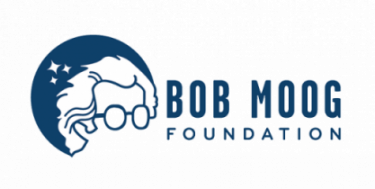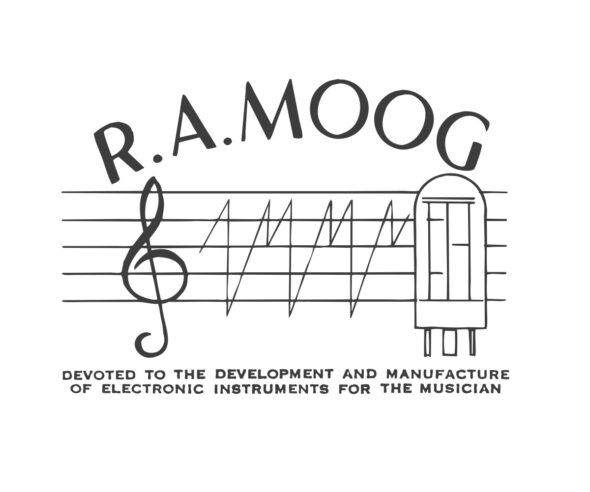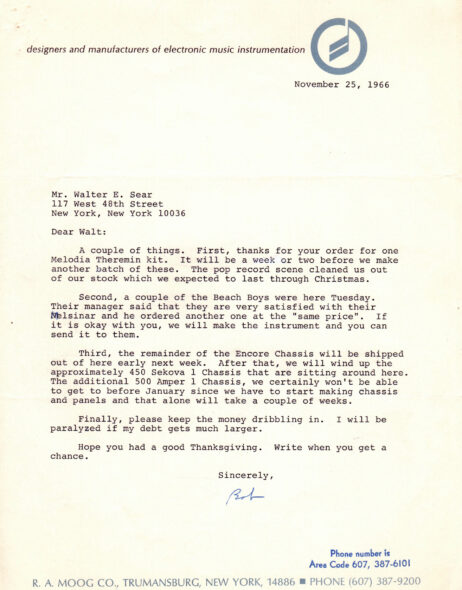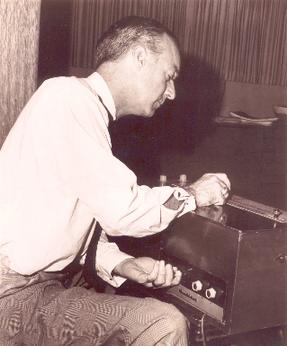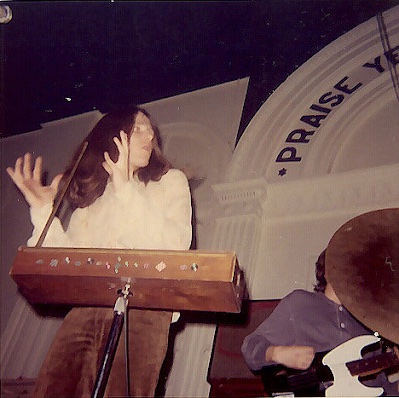
John Emelin in 1967 playing a Moog Troubadour Theremin with the psychedelic band Lothar and the Hand People (2021 Historia de la Musica Electronica Popular).
A note: You can turn to Thom Holmes’ podcast to hear all the tracks included here that use a Moog theremin as well as some others from the last 100 years of theremin recordings.
As influential as the Moog synthesizer has been, Bob Moog’s original focus in electronic music was the theremin. He began building theremins and then offering kits for other do-it-yourselfers when he was a teenager in upstate New York. By the time Bob Moog began to market modular synthesizers in the mid-’60s, he already had more than ten years’ experience building theremins, listening to musicians, and networking at various engineering and music trade shows.
The theremin as originally conceived by Leon Theremin in 1920 was an electronic instrument for live musical performance. Thirty years later, in the age of the tape recorder and transistor, Moog revived the theremin for the new age of live performance. The instrument attracted many artists, from those who produced music and sound effects for movies to rock, jazz, and classical musicians, who had an interest in exploring brave new sonic structures that could be controlled as any other musical instrument.
Several years before his famed synthesizer would materialize as a commercial product, Bob Moog began a small business building transistorized theremins. An electronics hobbyist since his youth, Moog had learned how to build theremins while still in high school — and continued to do so while a student at Corneill University in Ithaca, New York. In a conversation with me in 2002, Bob recalled:
The height of my theremin building was in college. We had a three-room apartment on the top floor of a house. For $10 a month, the landlord let me have the furnace room to build theremins in. So, all through graduate school I had a 10′ x 11′ furnace room as my shop. I built quite a few theremins there.The height of my theremin building was in college. We had a three-room apartment on the top floor of a house. For $10 a month, the landlord let me have the furnace room to build theremins in. So, all through graduate school I had a 10′ x 11′ furnace room as my shop. I built quite a few theremins there. [i]
“Quite a few” translated to about 1,000 theremin kits sold during the height of Moog’s little business. That’s twice as many as the original RCA theremin sold in 1930. Moog’s love for the theremin and the mysterious Russian inventor whom he had never met until later in life set him squarely on the path to the invention of his ground-breaking Moog synthesizer several years later. As for the theremin, Moog Music still produces Etherwave models, arguably the most widely sold theremin brand in the world today.
Before we explore some of the recording artists who have used Moog theremins, I want to mention one entertaining side story that has a tangible connection to Bob Moog.
The Story of “Good Vibrations,” by the Beach Boys
As you are probably aware, an instrument sounding peculiarly like a theremin surfaced in 1966 as the signature sound of the hit song Good Vibrations by The Beach Boys. Although the instrument heard on that record was not actually a theremin, it led to a connection between Brian Wilson and Robert Moog. First, a little backstory for context.
The late Paul Tanner was a top-notch trombonist in Hollywood working in movies and television. He was in great demand as a session man. In about 1958, Tanner sat in as a musician on the re-recording sessions for the Spellbound soundtrack, which was being updated to produce a stereophonic version of the music. It was during these sessions that he first observed Dr. Samuel Hoffman coaxing his mesmerizing electronic sounds from his original RCA theremin. Tanner could relate the space-controlled nature of theremin performance to the inexact science of moving the slide on a trombone. This motivated him to go into competition with Hoffman as another provider of spooky musical effects.
Tanner spoke with his friend Robert Whitsell about his idea to make a theremin. Whitsell had made a few of the instruments as a teenager. But as the two of them discussed the project further, it was clear that Tanner wanted an instrument that could be controlled more easily than the traditional space-controlled theremin used by Hoffman. Although they originally had a theremin in mind, what Whitsell built was something else entirely.
The “instrument” was no more than two off-the-shelf components from Heathkit: an oscillator and an amplifier. Whitsell designed a clever way to house the components that both disguised them from the observant eye and made the oscillator easy to play for a musician. The oscillator was hidden inside a wooden box. On top of the box was a strip of paper with a 15-inch image of a keyboard. A sliding handle could be moved along the length of the paper keyboard. The handle itself was attached through a pulley-and-cable mechanism to the rotary dial of the oscillator hidden inside the box. Moving the sliding handle turned the dial in one direction or another, changing the pitch. Volume was controlled simply by turning the volume control of the amplifier component. [ii]
This design offered Tanner the control he needed to accurately play a sequence of prescribed notes.
Whitsell’s “instrument with no name” was finished in the early morning hours of the day of their first gig: a recording session in 1958 for an album that would be called Music for Heavenly Bodies (1958), with an orchestra conducted by André Montero and arrangements by Warren Baker. Both Tanner and Whitsell took part, with Tanner doing the playing. [iii] Whitsell was on hand in case the instrument broke down.
The nameless instrument was apparently christened the “Electro-Theremin” by the producer of the recording or by Cy Schneider, the author of the liner notes. [iv]
Tanner and his Electro-Theremin were an instant hit with Hollywood music producers. After making some adjustments to the design—specifically to improve the manual articulation of the notes—Whitsell stepped out of the picture and Tanner was off and running with the novel new instrument. He went on to do sound effects for several Warner Brothers’ movies as well as television shows for ABC, CBS, and NBC.
Tanner’s most famous Electro-Theremin gig came when Brian Wilson of The Beach Boys asked him to join their 1966 recording sessions. These were the sessions leading up to the album Pet Sounds and the single “Good Vibrations.” The first piece on which Tanner played was “I Just Wasn’t Made for These Times.” It was followed a few days later by the first of many sessions for the landmark “Good Vibrations.”
When it came time to take the show on the road, The Beach Boys asked Tanner to come along, but he declined. He was a busy musician and instructor in California and could not take time out to join them. The group had by this time heard of Robert Moog and his theremins. They called him and asked if he would construct a portable instrument that could be used in concerts. It is a popular misconception that what Moog built for them was a theremin. What he actually provided was a transistorized audio oscillator housed in a slim walnut box about two feet long and six inches wide that was played by sliding the finger along a ribbon controller, which as Bob explained to me was no more than “a thin metal band, covered with Teflon-impregnated cloth.” [v] The instrument was handheld, had a volume control, and was powered by being plugged into the wall. It could be marked at the places where the finger had to stop to play the notes of a song.
Moog himself referred to the instrument as a Melsinar.[vi] Interestingly, for his current concertizing, Brian Wilson brought back the Electro-Theremin, or “Tannerin,” in the form of a replica built by Tom Polk, which is played by multi-instrumentalist Probyn Gregory of Brian Wilson’s band.
Timeline of Theremin History and Models
What about the true theremins and their history? I’ve created the following timeline that follows the course of theremin evolution. Moog theremins have been with us for the past sixty years. I’ve tried to include every production model and several key makes and models by other companies. Note that I’ve included the Gibson Maestro theremin, which was a design of Bob Moog’s, but sold by the Gibson guitar company.
Timeline of the Theremin
@2023 Thom Holmes
The following lists major models of the theremin and similar devices, organized by year.
1920 Leon Theremin invented the theremin in the Soviet Union and gave a concert late in the year.
1924-25 Leon Theremin was granted a patent in Russia for his Termenvox (theremin) and applied for patents for the instrument in Germany and the United States.
1927 Leon Theremin demonstrated his instrument in the United States. He played two different models during this period before the introduction of the RCA theremin. One was a floor cabinet model with control switches on the left side and the other was a tabletop model with two towers housing one antenna each, joined by a matching base.
1929 The RCA theremin was introduced in the United States. About 500 were sold. Lennington Shewell (1909-78, American pianist and songwriter) recorded several discs for RCA. Shewell was employed by RCA to travel around the USA demonstrating the theremin as part of its marketing campaign. His father was George Dunbar Shewell (1876-1938), who was vice-president of RCA at the time.
1933 Martin Taubman invented the Electronde, a theremin-like instrument that controlled the volume with a foot control, and the interruption of sliding notes with a hand switch.
1937-39 Teletouch theremin built by Leon theremin; a second attempt to sell the instrument by his own company after the lack of success of the RCA theremin.
1950 (circa) Dr. Samuel J. Hoffman, played an original RCA theremin that had been modified to include an integral loudspeaker in the lower part of the floor-standing cabinet. Hoffman himself added output jacks so that external speakers, or a soundboard, could be plugged into the amplifier of the instrument. This facilitated his recording for his most famous contributions to the theremin repertoire, such as the eerie sounds that played such an important role in the 1951 film, The Day the Earth Stood Still.
1953-54 Bob Moog designed his first theremin. Introduced the model 201 vacuum tube model. It had control dials for volume, pitch, octave, and its internal speaker. An innovative feature of this theremin, and a departure from the RCA model, was an Overtone Selector switch that allowed the performer to select or reject various harmonics. It was the first theremin produced since 1930 the introduction of the RCA theremin (with the exception of Leon Theremin’s short-lived, privately produced Teletouch theremin in 1937-38).
1954 In January, a 19-year-old Bob Moog published his article about making a theremin in Radio & Television News magazine. Moog then produced kits for making the models 201, 305, and 351. Moog sold about 20 of the model 201. Late in 1954, Moog introduced two additional models, the 305 and 351. Both were high-current vacuum tube instruments but without the internal speaker amplifier of the 201, allowing the models to be somewhat less bulky and heavy. The 305 and 351 had a five-octave range. The model 351 was identical to the 305 except that it featured an overtone control for adding harmonics to the basic sound.
1957 Moog produced the Vanguard model theremin, using vacuum-tube technology, and the Professional model, his first solid-state, transistorized theremin. The Professional model was distinguished by having a timbre control or tone control to further modify the sound.
1958 Electro-Theremin invented by Paul Tanner and Robert Whitesell. Not actually a theremin, but an oscillator contained in a box with a dial for controlling it. Used famously for the recording of Good Vibrations by The Beach Boys.
1961 Moog introduced the Melodia theremin. Notably, the Melodia established the basic design seen later in the Etherwave. Melodia was a kit version and was also the first theremin used by Herb Deutsch, who had purchased the kit from Moog. It was a more compact, transistorized model that could be run on a 6-volt battery. It was played using the left hand to control the volume antenna, which was a brass plate on the left side of the unit. The right hand controlled the pitch by gesturing near an upright antenna.
1962 Moog introduced the Troubador theremin. The Troubador followed the same transition to transistors and design of the Melodia. The Troubadour was fully assembled and was powered by a 115-volt, AC power supply instead of a battery and it featured the addition of continuously adjustable tone control. Like the Melodia, the Troubadour was played using the left hand to control the volume antenna, which was a brass plate on the left side of the unit. The right hand controlled the pitch by gesturing near an upright antenna.
1966 Moog created the Melsinar, for the Beach Boys, a sine wave generator with a ribbon controller and a printed keyboard to accurately mark the notes that were needed. The Beach Boys used this in live performances of “Good Vibrations,” “Heroes and Villains” and other songs requiring a theremin-like sound.
1969 The Sonic Wave theremin, “the Sounds of Time,” was made by W. Turner Inc. (USA) and was powered by a 9-volt battery. The Sonic Wave featured only one antenna, controlling the pitch, while loudness was controlled by a volume knob. Famously used by Jimmy Page of Led Zeppelin. A newer version with these characteristics has been manufactured by Theremaniacs since 1993.
1972 Gibson Maestro TH-1 theremin. The TH-1 was designed by Bob Moog in the early 1970’s and used two square plates to control the volume and pitch of the instrument instead of antennae. First made by Southwest Technical Products (SWTP). This was sold to customers of the company’s guitars and amplifiers, including rock bands and jazz artists.
1973 Ronnie Montrose added a custom-built theremin to his equipment with the pitch antenna mounted on his aluminum (silver) Velano guitar so that he could play both at the same time.
1982 Bob Moog, working under the name of Big Briar, introduced the Model 500 theremin-like controller, not exclusively a theremin, which resembled the body plan of the earlier Troubadour theremin.
1991 Big Briar introduced the models 91, 91B, and 91C cabinet-style theremins. The 91B had the two separate towers for the theremin antennae, which resembled one of Leon theremin’s original models.
1993 Theremaniacs remanufactured The Sonic Wave theremin used by Jimmy Page of Led Zeppelin. It featured only one antenna, controlling the pitch, while loudness was controlled by a volume knob.
1994 The Pavlov theremin Model 1994 was designed by George Pavlov and Yaroslav Schelkunov (graduate students of Moskow Institute of Radio Engineering, Electronics and Automation) in 1994. Pavlov is the husband of thereminist Lydia Kavina, who consulted on the project. Limited production.
1997 Moog Ethervox theremin introduced. This high-end professional tabletop instrument with the pyramid-shaped profile was MIDI-compatible.
1998-2000 George Pavlov created the TVox Tour model theremin. This model has been used by Lydia Kavina and the late Barbara Buchholtz. Limited production.
1996 Big Briar introduced the Etherwave theremin in Asheville, NC, arguably the most popular model ever when it became one of the first products sold by the revived Moog Music company (2002). This solid-state model had a similar body plan to the original Troubadour model (1962) but replaced the brass plate previously used to control volume with a volume control antenna. It could be played on a desktop or mounted on a microphone stand.
2000 The PAiA 9505 Theramax theremin (one of many kits from this maker of affordable synthesizer modules). Their current offering is the PAIA Theramax in a lectern-style cabinet.
2004 Moog Etherwave Pro theremin, a fully professional model. Front panel controls included a range switch for choosing octaves, timbre control with five presets. Included headphone output with level control and a sound preview mode. Pitch and Volume Control Voltages, for interfacing the Etherwave Pro with the Minimoog Voyager Synthesizer, or Moogerfooger Analog Effects.
2009 Wavefront Technologies began producing two professional-quality theremins, the Wavefront Classic and the Travel Case model.
2012 Burns theremins (Conyers, Georgia) began manufacturing finely crafted and affordable instruments. The B3 theremin, the Zep, with a single antenna for pitch ala the Sonic Wave, and a handheld theremin among other models.
2014 Moog theremini introduced. New theremin design fused the experience of gesture control with a sound engine derived from Moog’s synthesizer, Animoog. Assistive pitch correction, MIDI, a built-in tuner display providing visual feedback, and presets available for 32 wave or wavetable-based sounds and scales.
Engineer and teacher Charles Hobbs makes his limited production High-End theremin, hand-built models with a wood enclosure, hand-wound coils, and antenna in Brooklyn New York.
2020 Moog Claravox Centennial theremin. “Named after the original theremin virtuosa, Clara Rockmore, Claravox Centennial features the highest quality control and sound available in a theremin for deep artistic exploration.” Switchable Traditional and Modern performance modes allow the player to choose between classic heterodyne oscillators (for a genuine analog theremin experience) and multimode DSP oscillators (sine, triangle, saw, wavetable) with assignable scales, quantization, octave ranges, and response curves.
2021 D-Lev Digital theremin kit available followed by limited production models. “The digital theremin employs oscillators that vary in frequency with the capacitance of the player’s hands. The exact same electrostatic interaction is at work, and the heterodyned frequency difference is replaced by a simple and noiseless arithmetic subtraction. Musicians who are accustomed to traditional analog theremins won’t have to alter their fundamental style or techniques in order to play the D-Lev (unless they want to).” (Eric Wallin, D-Lev designer)
For more information to illuminate this timeline, please take a look at these pages on the Google Arts & Culture website.
Now that we have the history of the theremin sorted, let’s turn to some recordings you might like to hear that feature a Moog theremin. All of the tracks and artists mentioned here are featured in the current two-part episodes of my podcast, The Holmes Archive of Electronic Music, which I invite you to stream and enjoy. Plus, I’ve featured many other recordings using non-Moog theremins, such as the TVox Tour model theremin played by Lydia Kavina and Barbara Buchholtz, Ronnie Montrose’s custom-made guitar-theremin, and many others that were hand-built.
Theremin Recordings — A Quick Survey from 1968 to 2023
Artists far in wide have used a Moog theremin in their recorded work and live performances. I have selected the following examples that represent a wide range of styles from classical to psychedelic. I state in each description the Moog theremin model that was used, if known. I’ve organized these in chronological order.
Ultimate Spinach, “(Ballad of The) Hip Death Goddess” from Ultimate Spinach (1968 MGM Records). This American psychedelic rock band was from Boston, Massachusetts, although they had a sound that had more of an affinity with the free spirit of San Francisco. The theremin has a prominent part in this song, tracking the vocalist and filling in some interesting instrumental parts.
Hawkwind, “Paranoia Part 2” from Hawkwind (1970 Liberty). Hawkwind is and was a pioneering space-rock and psychedelic group from the UK. They were known to use a theremin during their early years—1969 to 1973 and revived its use on stage in later performances using a Moog Etherwave model in the 2000s. This first album featured a theremin added to boost the sonic textures of their music. The theremin was sometimes used overtly but often run through effects to provide a looming background, as in this song. Likely a Moog Troubador theremin.
McKendree Spring, “God Bless the Conspiracy” from 3 (1972 Decca). Electric violin, viola, theremin, Michael Dreyfuss. Dreyfus later said, “In God Bless the Conspiracy and No Regrets I was able to play viola and theremin at the same time by bringing my body closer to the theremin (to change pitch) while playing a harmony part on the viola” (2006). He played a theremin beginning in 1969, likely a Moog Troubador model.
Linda Cohen, “Horizon Jane” from Lake of Light (1973 Poppy). Folky album from Philadelphia featuring several electronic musicians from the Philadelphia scene, including Jeff Cain, Craig Anderton and Charles Cohen. Charles played was likely a Moog Troubador theremin on this track.
Arthur Brown’s Kingdom Come, “Time Captives” from Journey (1974 Passport). Progressive rock band from the UK featuring Arthur Brown on vocals and Victor Peraino on a Moog Troubador theremin (likely), plus ARP 2600 and EMS VCS 3 synthesizers.
Michael Quatro, “Get Away” from In Collaboration with The Gods (1975 United Artists Records). Brother of Detroit rockers Suzi and Patti Quatro, he had a flare for progressive rock and electronic keyboards in the 1970s. The Maestro theremin designed by Bob Moog for Gibson made frequent appearances on this album, this track in particular. In addition to theremin, Quatro played the Baldwin piano, Gretsch Electro, Moog Sonic Six Synthesizer (1972), Minimoog Synthesizer, Mini-Korg, Mellotron, and Pipe Organ,
Todd Clark, “Into the Vision” from Into The Vision (1984 T.M.I. Productions). This montage of electronic sounds and effects features a Moog Troubador theremin (likely), Bat-wing Guitar with ARP Avatar, plus “found” vocals by William Burroughs.
Danielle Dax, “Yummer Yummer Man” from Yummer Yummer Man (1985 Awesome). UK artist, vocalist and theremin player Danielle Dax likely used a Moog Troubador theremin on this track. Dax is an experimental English musician, artist, and producer.
Mars Everywhere, “Attack of the Giant Squid” from Visitor Parking (1989 Audiofile Tapes). Cassette release from this space-rock band from the 1980s. Moog Troubador theremin (likely) and other keyboards by Tom Fenwick.
Jon Spencer Blues Explosion, “Vacuum of Loneliness” from The Jon Spencer Blues Explosion (1992 Caroline). This NY band uses an original Moog Vanguard (circa 1960). This rock and blues band was active from 1991 until 2016. Vocals, Guitar, Moog Vanguard theremin, Jon Spencer. Here is a video of a live performance of The Jon Spencer Blues Explosion with a Moog Vanguard theremin (just after the 39-minute mark). 3:02
Calvin Owens and His Blues Orchestra, “Vincent Van Gogh” from That’s Your Booty (1996 Sawdust Alley). One of my favorite theremin artists is Youseff Yancy. He is in great form on this track from 1996. Yancy uses one of two original Maestro theremins that he owns from the 1970s. This is a lush and captivating piece that has been fully orchestrated for Owens’ jazz ensemble.
David Simons, “Music for theremin And Gamelan (1998-1999), parts I and II” from Fung Sha Noon (2009 Tzadik). Moog Melodia theremin, Rob Schwimmer. Here, the theremin became part of an interesting ensemble of new music for gamelan orchestra and other instruments.
The Kurstins, “Sunshine” from Gymnopedie (2000 Rouge Records). Composed by Roy Ayers. This was from Kurstin’s original theremin recording done with Pamelia’s husband, as is the following track. Pamelia immediately displayed a sense of playful lyricism that could be drawn from the Moog Etherwave theremin. Other instruments on this tracks included the Minimoog, ARP String Ensemble, Organ, Vocoder, and Moogerfooger effects modules.
The Kurstins, “Outside” from Gymnopedie (2000 Rouge Records). More from Pamelia on the Moog Etherwave theremin, Vocoder, and Moogerfoogers.
Hecate’s Angels, “Shrink-Wrapped Soul” from Saints and Scoundrels (2004 redFLY Records). Los Angeles-based Pietra Wexstun is a composer, singer, keyboard, and theremin player. Vocals, Farfisa organ, piano, Moog Etherwave theremin, sound effects, Pietra Wexstun.
Pamelia (Kurstin) Stickney, “Barrow in Furness” from Thinking Out Loud (2007 Tzadik). From Pamelia Stickney’s first solo record. She played the Moog Etherwave Pro theremin, Line 6 Looping Pedals, and Moog Microsynth Pedal. Pamelia Stickney video with her and Bob Moog discussing the Etherwave Pro when it was introduced.
Carolina Eyck & Christopher Tarnow – Improvisations For Theremin And Piano. Carolina Eyck plays a Moog Etherwave Pro theremin in this collection of theremin and piano improvisations in a classical style.
Herb Deutsch, “Longing” from theremin One Hundred Years (2020 Electronic Sound). Composer, Herb Deutsch; Piano, Nancy Deutsch; Moog Melodia theremin, Daryl Kubian. Recording from 2012. The beloved Herb Deutsch, who died recently at age 90, was an early collaborator with Bob Moog on the creation of the synthesizer. Herb became acquainted with Bob by purchasing a theremin kit—a Moog Melodia model—in the early 1960s. This track is also found on a terrific compilation of modern theremin artists to benefit the New York Theremin Society. Check it out.
M83, “Sitting” from M83 (2016 Lowlands Festival). M83 is a French electronica band founded in 1999 by Anthony Gonzalez. This is a live recording from Holland. “Sitting” was a song on M83’s first album in 2001. But it didn’t have a theremin part until they decided to spice up the live interpretation of the song in 2016. Jordan Lawlor used a Moog theremini when M83 performed this in concert. He put down his guitar, grabbed some drumsticks, and beat a rhythm on some electronic drums while dancing in place and moving his hands around the theremin. You can hear the theremin in this track but don’t mistake it for the keyboard tones that leader Gonzalez is playing on his modular system. A longer sequence of theremin begins at 1:38 in the audio. You can view the video here, beginning at 26:54 into the show.
Thorwald Jørgensen, Kamilla Bystrova, “Moderato” from Air électrique: Original Music For Theremin And Piano (2020 Zefir). Jørgensen is an accomplished Dutch classical theremin player who uses a Moog Etherwave Pro theremin.
Dorit Chrysler, “A Happy Place” from Theremin One Hundred Years (2020 Electronic Sound). Issued with the magazine’s 7” vinyl and magazine bundle Electronic Sound Magazine, issue 70. Written, produced, and performed by Dorit Chrysler. Chrysler uses Moog and Hobbs theremins.
Dorit Chrysler, “Calder Plays Theremin Side A” from Calder Plays Theremin (2023 NY Theremin Society/Fridman Gallery) Written for theremin orchestra in 5 Movements, Chrysler’s work is based on a commissioned sound piece by The Museum of Modern Art in conjunction with the exhibition Alexander Calder: Modern from the Start. I want to thank fellow author Albert Glinsky, who wrote the book about Leon Theremin, for sharing his liner notes for the upcoming release by Dorit Chrysler of her Calder pieces. For those works, “Chrysler identified two of Alexander Calder’s sculptures, Snow Flurry, I (1948) and Man-Eater with Pennants (1945), to interact and “play” multiple [Moog] theremins on site.” In Albert’s liner notes he explained how Chrysler realized these pieces. Quoting Albert, he explained, “Recording the interplay of sculptures and antennae on site, Chrylser returned to the studio to sort and manipulate the sounds, mixing them into finished compositions in the best tradition of musique concrete.”
A final word: There is a marvelous collection of contemporary thereminists that was released in 2020 on the 100th anniversary of Leon Theremin’s instrument. Theremin 100: Electronic Music Written for the Theremin. Albert Glinsky also wrote the liner notes for this collection of 50 tracks exploring the instrument from all directions and styles.
[I] Robert Moog, interview with Thom Holmes, March 4, 2001, as appears in Holmes, Electronic and Experimental Music (6th edition), published by Routledge.
[ii] David Miller, personal communication with Thom Holmes, April 23, 2001. Miller was a personal acquaintance of both Paul Tanner and Robert Whitsell, as appears in Holmes, Electronic and Experimental Music
(6th edition), published by Routledge.
[iii] David Miller, personal communication with Thom Holmes, May 5, 2001.
[iv] Ibid.
[v] Robert Moog, personal communication with Thom Holmes, April 23, 2001.
[vi Correspondence with Moog biographer Albert Glinsky, March 29, 2019.

